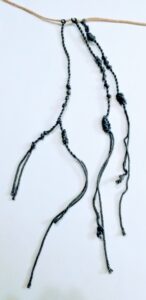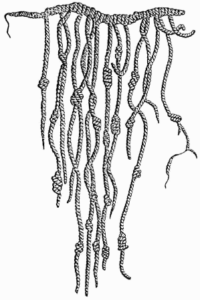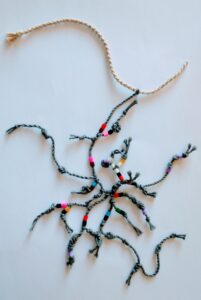
Being inspired by Quipu, and also Dave and Julian‘s work on visualising and sonifying Quipu data (their “coding with knots” paper is here, will link to preprint soon..), I thought I’d have a go at making some. Quipu seem to be ancient databases, used to archive and communicate information. They were in use by Andean people over hundreds of years. The goal is to encode Tidal patterns in a similar manner, which I think was also Dave’s idea. So far, I think this should work very well.. Some initial (and of course, naive) thoughts about trying to make Quipu are below.

I started with four-ply 100% cotton handknit yarn, which was less fluffy and easier to work with than sheep’s wool. It did cross my mind to try to find Alpaca wool for authenticity, but it was not very easy to find, and I read that cotton was used in the Quipu too. After a bit of knotting things weren’t going too well, due to the stretchiness of the yarn it was difficult to get the knots close together, and it was all a bit fiddly.. Especially for the ‘end knot’ in a number which requires you to pass the yarn through its own loop up to nine times, securing itself in neat spiral. I wondered whether this yarn had the right structure for the task..
Looking closer at the diagrams and photographs of Quipu on-line though, it became clear that the Quipu yarn was ‘doubled’ – folded in half and twisted together to create a loop at one end, which could then be used to attach to another piece of yarn with a ‘cow hitch’. I found I could double small pieces of wool quite easily by hand, by twisting it with the direction of the existing twist until I met resistance, folding the yarn in half, and letting it twist together. Happily, the result was a yarn which was not only easy to hitch (and un-hitch) from another piece, but also was much easier to work with, in terms of tying the knots and getting them to sit in the right place, with a little help from a 20mm crochet hook.
It seemed important to start knotting at the bottom of the doubled yarn, otherwise it would start to unravel back to its original 4-ply. In terms of the Quipu representation of natural numbers (which handily, is base ten), this meant starting by knotting the unit, and then the tens, and so on. Once attached, the threads were easy to move along the thread they were attached to, and un-hitch if necessary.
I’ll need a lot more practice to make the knots more ‘readable’. Yarn is twisted in a particular direction – in this case the ‘Z’ rather than ‘S’ direction, so perhaps the knots have to match in terms of whether they’re right or left handed. There is a suggestion that the direction of twist and handedness of the knot is significant in terms of information storage, I’m a bit sceptical about this, as least they appear to be dependent on one another. For now I’m putting a little bit of twist into the yarn as I tie the knot to make sure the ply doesn’t ‘open up’.
Anyway, I think I have some grasp of how this can work now. The next task is to try to notate Tidal patterns. The ability to hitch threads to the side of others should make knotting together the parse tree of a TidalCycles pattern fairly straightforward. I’d also like to use beads to represent things which aren’t directly numerical, such as sound samples — Hama beads look perfect for this, the right size, available in bulk in a wide range of colours, and cheap! Hopefully I’ll have something to show at my lunchtime talk at the ODI this Friday.
*Update* I did indeed manage to transliterate some Tidal code into knots and beads, in particular taking this by Kindohm:
jux (|*| speed "1.5") $ foldEvery [3,4] (0.25 <~) $ stack [
s "less:2([3 5]/2,8)" # unit "c" # speed "4",
s "less(3,8)" # cut "1" # up "{0 -3 1}%32",
s "{~ [~ cp] ~ less:3/2 ~}%4",
s "[less:1*2 less:1]*2"]
I created this:
I’ll post again with more explanatory detail, but from my notes..
- Knots are numbers, including a slightly awkward attempt at representing rational numbers
- Values which are not directly numerical are represented with beads. Samples are yellow for cp and purple for feel (the sample number is a number, so is a knot). As an exception, single letters of the alphabet are treated as ordinal numbers and so represented with knots, e.g. c = 3.
- Function names are a bead followed by a brown bead. In particular, red brown for jux, pink brown for foldEvery, blue brown for ~>
- Subpatterns and functions-as-parameters are separate strings tied on to the side (currying works out fine)
- Parameter names are a bead followed by a black bead. red black for sound, green black for cut, blue black for up, pink black for speed.
The parse tree comes out rather nicely I think, and is almost a complete representation of the original pattern (I decided to overlook the difference between # and |*| for this first attempt). I’m trying to minimise the use of beads, treating colours as logograms feels like cheating, simply making a text out of an alphabet of colour. The branching structure is what takes it away from one dimensional text though, and into something which is much closer to that of a running computer program (particularly a pure functional one like a Tidal pattern).
The next step is to try to compose a new pattern directly as string, to explore its affordances.. Maybe this could inspire a breakthrough in usability for my Texture interface for Tidal..
